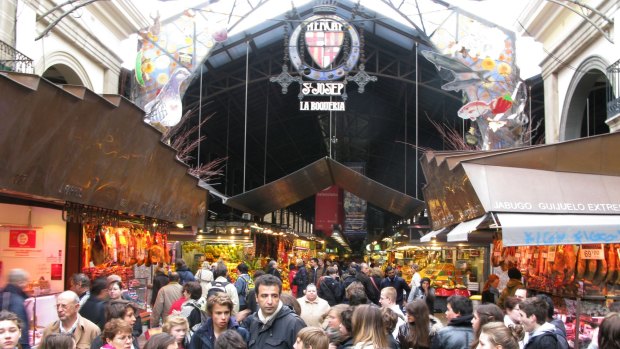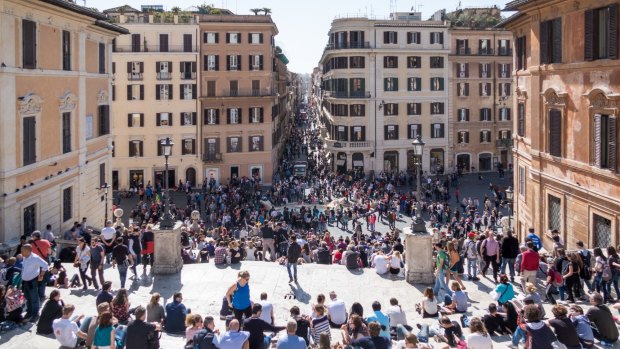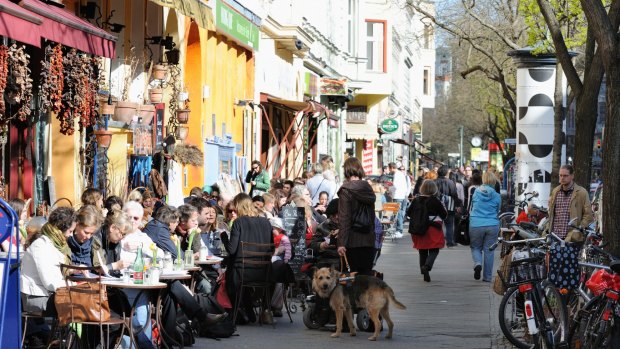This was published 6 years ago
Barcelona, Berlin, Rome and Venice: The cities that are sick of tourists
By Ben Groundwater

La Boqueria market in Barcelona.Credit: Alamy
"Gaudi hates you."
That's one of the more amusing pieces of graffiti that has appeared in Barcelona recently, one of a few pointed references to the fact the city's residents aren't exactly happy these days about living in one of the world's most popular tourist destinations. You might be visiting Barcelona because you love Gaudi, but would Gaudi love you?
The famous Catalan architect might well be horrified to see what his elegant city has become thanks to the modern influx of tourists: the tacky T-shirt stores that crowd every corner; the hundreds of peddlers of those stupid glow-in-the-dark things you flick into the air; the food markets that are now filled not with discerning shoppers, but with gawking tourists fighting for selfie-stick room.
Maybe Gaudi would have hated that. What's more certain, however, is that some of Barcelona's current residents do.
You can see it in the graffiti. You can see it in the harsh laws attempting to halt the spread of services like Airbnb, a vain attempt to keep the stag-do crowd out of the suburbs, to keep the photo-taking foodies out of the locals-only bars. You can see it in the faces of the market sellers who have to contend with huge crowds of onlookers who don't want to buy anything.
No wonder there's a backlash. Surely people in Barcelona don't want to live in a tourist attraction, don't want to exist purely as a backdrop for Instagram photos. They want to live in a normal city, a place where they'll have the same neighbours next week and the week after, where they can go to the market and buy some jamon and not have to push past a group of hungover tour passengers taking photos of the tomatoes to get there.
And the Catalans aren't the only Europeans beginning to push back against the weight of the tourist hordes. There are signs that the Romans, too, have had enough. There's now a "picnic ban" in the Eternal City, forbidding tourists from stopping to eat on top of well-known sights such as the Spanish Steps. Visitors will also be fined if they sit on the edge of historic fountains, including the Trevi, or, worse, attempt to dive into one for a hilarious novelty bath.

Spanish Steps, Rome.Credit: iStock
In Berlin there's a similar feeling of frustration. Rent is skyrocketing and suburbs are rapidly gentrifying, particularly neighbourhoods like Kreuzberg and Neukolln, thanks to the arrival of tourists and their money. Venice, too, has long felt more like a theme park that an actual living city.

Kreuzberg, Berlin.Credit: iStock
It was inevitable that there would be an adverse reaction to this mass tourism, to the sheer weight of numbers crowding streets and famous monuments, to the changes tourists bring to the social fabric of these cities. It's also understandable.
As a traveller, this presents you with a dilemma. You want to see the world, of course; you want to visit these amazing places that everyone else is going to. But you also have to respect the fact that you're adding to a problem here. You can tell yourself as much as you like that you're a "traveller, not a tourist", but no one knows the difference when you're just another body adding to the crush in the Boqueria market, when you're just another face in the crowd around the Trevi Fountain.
In fact, "travellers" are a major part of the issue. They want to get off the beaten track, they want to see the "real" city – but in doing so they're breaking down the traditional tourist/local barriers, they're popping up in quiet neighbourhoods, invading locals-only havens in the name of seeing something authentic. At least the tourist crowd just congregates in one spot and can easily be avoided.
So what do you do? What's the solution? I love Barcelona. I don't want to stop going there. Same with Rome. I've got carbonara to eat. I love Berlin with a passion. And I'm also the sort of person who seeks out those locals-only neighbourhoods, who wants to feel that they're seeing a side of the city that others are missing out on.
It's a difficult one to balance. The only thing you as a traveller can do, really, if you still want to visit, is attempt to limit your impact when you're in these cities: learn some of the local language so you're not making a nuisance of yourself in bars and restaurants; treat Airbnb apartments (and your temporary neighbours) like they're your own from back home; buy food when you go to gawk at a local market; talk to people instead of just pointing your camera at them; in fact, put your camera away for a while and just live.
It's not a perfect solution. But at least it's a thoughtful way to lessen your impact while still being able to see the world. Surely Gaudi would appreciate that?
Do you think tourists are a problem in places like Barcelona and Rome? Is it understandable that locals are tired of it? What do you do to lessen your impact?
Email: b.groundwater@fairfaxmedia.com.au
Instagram: instagram.com/bengroundwater
Sign up for the Traveller Deals newsletter
Get exclusive travel deals delivered straight to your inbox. Sign up now.